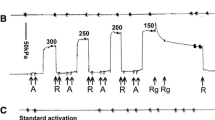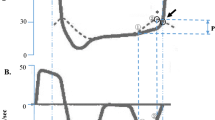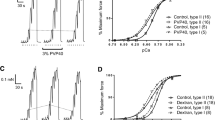Abstract
A sudden stretch (within 0.3 ms) of glycerol-extracted rabbit psoas fibre bundle suspended in ATP-salt solution caused an immediate tension increase followed by a rapid tension decay (quick phase) which was nearly completed within 3 ms. The quick phase was missing or much reduced in the absence of ATP when the fibres were in rigor. Since the immediate stiffness of the fibres was nearly the same at the onset and at the end of the quick phase, the latter cannot be due to cross-bridges detachment per se. However, it may be ascribed to a conformational change (e.g. rotation) of attached bridges as suggested by Huxley and Simmons. Alternatively it might be explained by a slippage of attached cross-bridges. This mechanism would presuppose fast detachment and reattachment of strongly strained cross-bridges during the quick phase. Evidence for such a process was obtained by analysing the tension transients obtained when fibre bundles subjected to a large stretch were subsequently (within 10 ms) released to the initial length, as well as from stiffness measurements during the sudden length change: The stiffness was not found to be constant either during stretch or during the release. This may be taken to mean that the number of attached cross-bridges does not remain constant even during a rapid length change. In view of these results, the model proposed by Huxley and Simmons might be extended to take account of rapid attachment and detachment of crossbridges.
Similar content being viewed by others
References
Abbott, R. H., Steiger, G. J.: Temperature and amplitude dependence of tension transients in glycerinated skeletal and insect fibrillar muscle. J. Physiol. (Lond.)266, 13–42 (1977)
Davies, R. E.: A molecular theorie of muscle constraction: calcium dependent contractions with hydrogen bond formation plus ATP-dependent extensions of part of the myosin cross bridges. Nature (Lond.)199, 1068–1074 (1963)
Eisenberg, E., Wayne Kielley, W.: Evidence for a refractory state of heavy meromyosin and subfragment-1 unable to bind to actin in the presence of ATP. Cold Spr. Harb. Symp. quant Biol.37, 145–152 (1972)
Ford, L. E., Huxley, A. F., Simmons, R. M.: Tension responses to sudden length change in stimulated frog muscle fibres near slack length. J. Physiol. (Lond.)269, 441–515 (1977)
Heinl, P., Kuhn, H. J., Rüegg, J. C.: Tension responses to quick length changes of glycerinated skeletal muscle fibres from the frog and tortoise. J. Physiol. (Lond.)237, 243–258 (1974)
Holmes, K. C.: The myosin cross bridge as revealed by structure studies. Int. Symp. Rottach-Egern/Tegernsee (eds. G. Rücker, et al.). Berlin-Heidelberg-New York: Springer 1977
Huxley, A. F.: Muscular contraction. J. Physiol. (Lond.)243, 1–43 (1974)
Huxley, A. F., Simmons, R. M.: Proposed mechanism of force generation in striated muscle. Nature (Lond.)233, 535 (1971)
Huxley, H. E.: Electron microscope studies of the organisation of the filaments in striated muscle. Biochim. biophys. acta (Amst.)12, 387–394 (1953)
Huxley, H. E.: The mechanism of muscular contraction. Science164, 1356–1366 (1969)
Julian, F. J., Sollins, K. R., Sollins, M. R.: A model for the transient and steady-state mechanical behaviour of contracting muscle. Biophys. J.14, 546–562 (1974)
Lymn, R. W., Taylor, E. W.: Mechanism of adenosine triphosphate hydrolysis by actomyosin. Biochemistry10, 4617–4624 (1971)
Podolsky, R. J., Nolan, A. C.: Muscle contraction transients, cross bridge kinetics, and the Fenn effect. Cold Spr. Harb. Symp. quant Biol.37, 661–668 (1972)
Reedy, M. K., Holmes, K. C., Tregear, R. T.: Induced changes in orientation of the cross bridges of glycerinated insect flight muscle. Nature (Lond.)207, 1279 (1965)
Simmons, R. M., Jewell, B. R.: Mechanics and models of muscular contraction. In: Recent advances in physiology (ed. R. J. Linden). Edinburgh-London: Churchill Livingstone 1974
White, H. D., Taylor, E. W.: Energetics and mechanism of actomyosin adenosine triphosphate. Biochemistry15, 5818–5826 (1976)
Yamamoto, T., Herzig, J. W.: Series elastic properties of skinned muscle fibres in contraction and rigor. Pflügers Arch. (in press)
Author information
Authors and Affiliations
Rights and permissions
About this article
Cite this article
Güth, K., Kuhn, H.J. Stiffness and tension during and after sudden length changes of glycerinated rabbit psoas muscle fibres. Biophys. Struct. Mechanism 4, 223–236 (1978). https://doi.org/10.1007/BF02426087
Received:
Accepted:
Issue Date:
DOI: https://doi.org/10.1007/BF02426087




